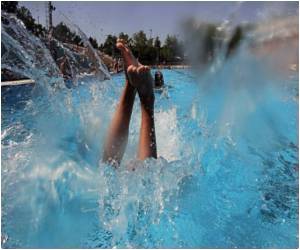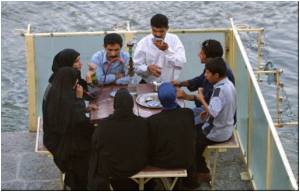
As he smears rosewater on fingers and squeezes lemon juice over toes, he speaks of a symbiosis of mind, body and universe and discusses forces that transcend the toxic political disputes gripping the territory.
"This place has nothing to do with the outside world. It's for people who love beauty," the heavy-set 33-year-old says as he applies sharp pressure to the feet of a young man laid out on a stone bench, who moans from the pain.
"Many people came after the war because they were tense and afraid," he says of the devastating 22-day Israeli assault launched in December 2008, which was aimed at halting Palestinian rocket attacks.
Visitors duck through an arched door tucked into a narrow alley in Gaza City, following a worn stairway down to a labyrinth of stone chambers dappled with sunlight from a constellation of tiny windows in the domed ceiling.
A stone plaque on the wall says the bathhouse was last renovated in the 13th century during the Mameluke empire that ruled from Cairo. Its owner, Selim al-Wazir, claims it has stood for 1,000 years.
Advertisement
The Al-Wazir family mostly supports the late Arafat's secular Fatah movement, but the hamam welcomes Palestinians of all political persuasions, including the Islamist Hamas which has ruled Gaza since 2007.
Advertisement
"We keep all our troubles far away from here, so we can preserve our history and our people," he says.
The hamam has survived decades of Israeli incursions, unscathed except for a bomb dropped during the 1956 war with Egypt that punched a hole in the roof, Wazir says. The damage has since been repaired.
"They know that the man who built this hamam was a Jew from near Nablus, so they don't attack it," he says, adding that Israelis used to come before the outbreak of the first Palestinian uprising in 1987.
The name Al-Samra refers to the Samaritans, an ancient religious community in the northern West Bank with close ties to Judaism.
Like other centuries-old hamams across the Middle East, Al-Samra carries on a tradition of public bathing dating back to Roman times, with visitors making their way through progressively warmer rooms, splashing themselves with bowls of water taken from basins, or sliding into warm pools.
Guests wear shorts or towels at all times, and there are separate hours for men and women.
"I come here every two or three days, because it's good for the kidneys," says Abu Eissa, 60, his body covered in suds. "Cleanliness is the key to good health."
Visitors can opt for Awad's massage, which incorporates Asian and Arab notions of wellness he picked up from reading books.
In another time and place, Awad might have formally studied massage and alternative medicine and gone to work for a day spa or a five-star hotel.
But like most Gazans of his generation, he has had few opportunities to travel outside the narrow coastal strip, the borders of which have been largely sealed by Israel and Egypt since Hamas seized power three years ago.
"I used to be a lawyer but I quit 12 years ago so I could do this," he said. "When you do what you love, it's a blessing to the world."
He begins by using a loofah to scrape off flecks of dead skin before rubbing lemon and apple juice on the feet and applying painfully sharp pressure to the heel and toes. Then he does the same to the hands and elbows, using rosewater.
He describes his work in mystical terms rarely heard in Gaza, explaining how toxins gather in the feet and block the energy that flows from the earth, and how open pores and rosewater let air and light into the soul.
Then he leads the guest into a steam room -- heated by an underground wood-burning furnace -- and briefly immerses him in a tank of hot water before leading him back to recline on a stone slab and elevate his feet.
As the muscles relax, a heavenly languor sets in, and nothing penetrates the subterranean chambers from the broken world above but the scattered rays of sunlight that pierce the swirling clouds of steam.
"The body is just a smaller version of the universe. It affects the world and is affected by it," Awad says. "A person cannot be separated from nature."
Source-AFP









